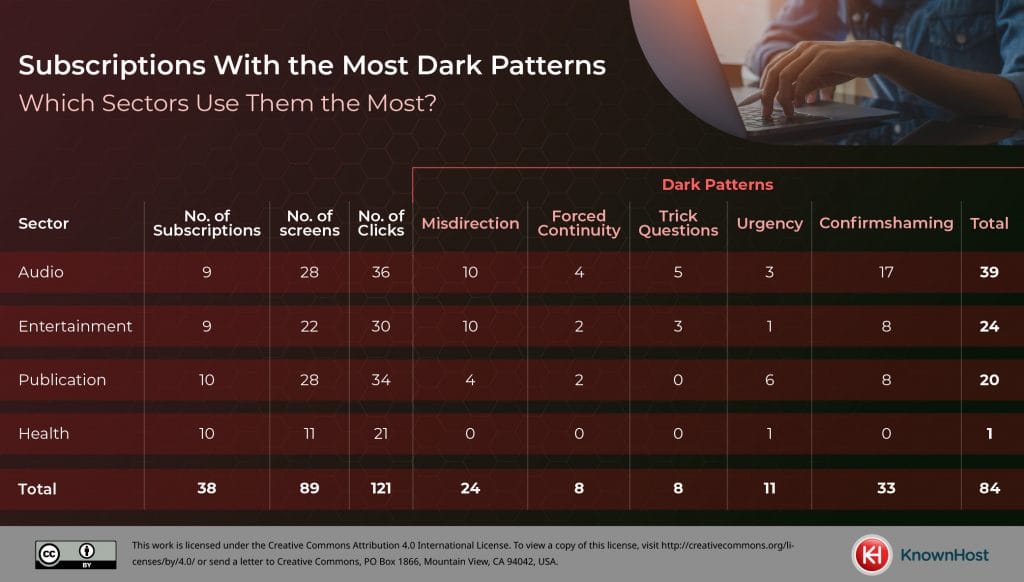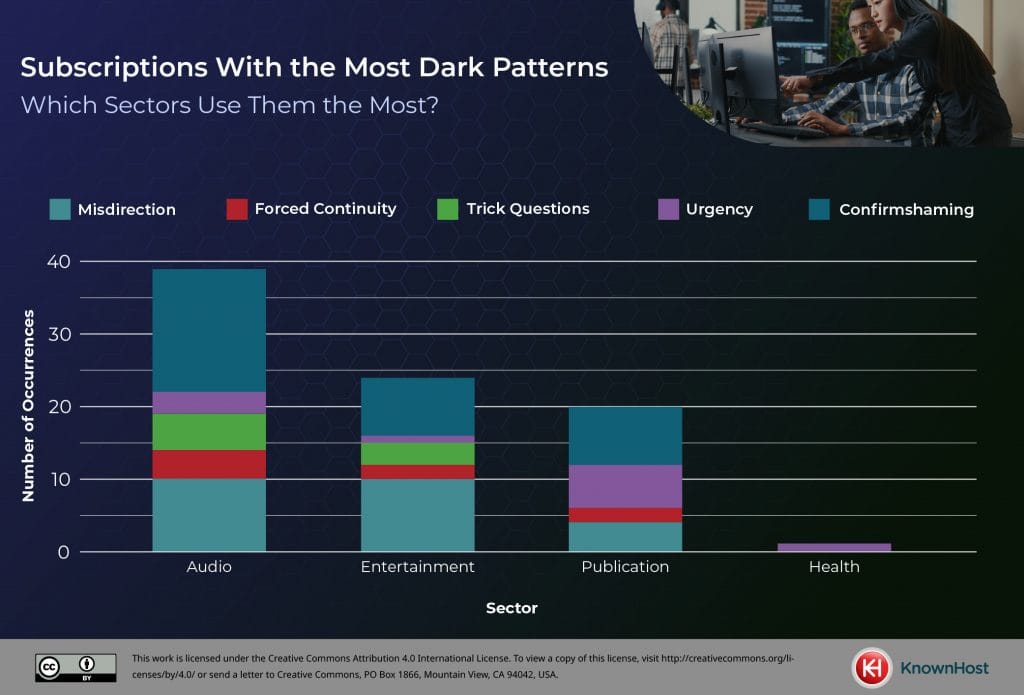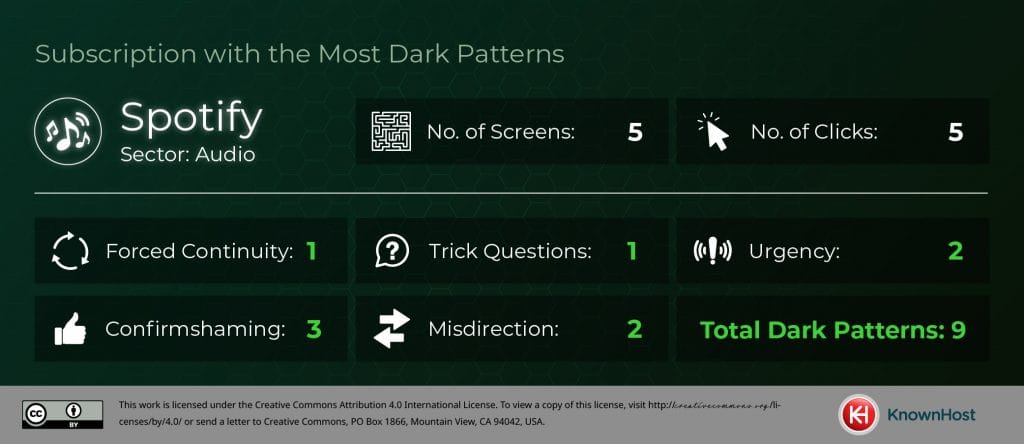Hardest Subscriptions to Cancel
Last Updated: June 2, 2025
Cancelling subscriptions has long been associated with frustration, confusion, and unnecessary delays. But that’s changing, especially in the U.S., where the Federal Trade Commission (FTC) has extended the enforcement deadline for its Click-to-Cancel Rule to July 14, 2025. The new rule aims to stop deceptive tactics and require that cancellation is as easy as signing up.
Meanwhile, other countries such as the UK continue taking steps to create simpler and more transparent cancellation processes, though enforcement varies across jurisdictions.
To evaluate how cancellation flows differ across industries, KnownHost analyzed 44 UK-based subscriptions across six major sectors: audio, entertainment, food delivery, gaming, publications, and health. The study tracked the number of clicks, screens, and dark patterns users encountered while trying to cancel.
Table of Contents
Methodology
For this study, KnownHost created a seed list across six subscription sectors, including Audio, Food Delivery, Entertainment, Publications, Health and Gaming. 44 UK-based subscriptions were then confirmed with their free trials and were each individually canceled, recording the number of clicks and screens it required to confirm cancelation. Along with this, a list of dark patterns were investigated and counted depending on the cancelation process.
Dark Patterns that were tested in the study:
To uncover which subscriptions make cancellation unnecessarily difficult, KnownHost examined not just the number of clicks or screens required, but also the presence of dark patterns which are manipulative design and language tactics used to confuse, pressure, or guilt users into staying subscribed.
These deceptive practices are increasingly under regulatory scrutiny, especially with the FTC’s Click-to-Cancel Rule set to enforce stricter standards starting July 14, 2025. Below are the specific dark patterns that were identified and tracked throughout the study.
- Misdirection – Use of design or layout to mislead users or bury cancel options.
- Hidden Costs – Unexpected charges or renewals not disclosed clearly during sign-up.
- Forced Continuity – Making it excessively difficult to cancel or automatically renewing without clear, affirmative consent.
- Trick Questions – Confusing or manipulative phrasing designed to secure agreement without clear understanding.
- Urgency – Creating false time pressure (e.g., “Offer ends today!”) to dissuade cancellation or prompt hasty decisions.
- Confirmshaming – Language that induces guilt or shame for attempting to cancel, such as “You’ll let everyone down!”
Note: As of July 14, 2025, many of these tactics will be subject to legal penalties in the U.S. under the FTC’s Click-to-Cancel Rule if not implemented in compliance with consent and ease-of-use standards.
Subscriptions with the Most Dark Patterns
Across these four sectors, a total of 84 dark patterns were recorded, requiring 121 clicks and 89 screens to cancel every subscription. Audio had the highest number of clicks with 36, whilst audio and publications had the same number of screens with 28.

For misdirection, audio and entertainment were joint with 10 cases recorded, whilst health had no recorded cases and publications only 4. Forced continuity was noted with 4 cases on audio subscriptions, dropping to twice for both entertainment and publications whilst health recorded 0. Confirmshaming was the most recorded dark pattern with 33 cases, with audio providing 17 of those cases.
Audio subscriptions used dark patterns 39 times during the cancellation process, whilst health apps had the fewest due to the simplicity of cancelling through app stores. However, there was one case of urgency with the availability of a discount offer.

Publications had the most cases of urgency as they offered multiple discounts and incentives, which appeared as a limited offer, to remain subscribed. During the in-person contact, there were multiple questions to confirm cancellation which were recorded as confirmshaming. Entertainment had the joint highest cases of misdirection, along with audio, using visual methods to confuse users into selecting the wrong response.
The Subscription with the Most Dark Patterns: Spotify
Spotify ranked as the subscription with the highest number of dark patterns overall:
1 case of forced continuity and trick questions
Spotify presented forced continuity by defaulting to auto-renewal without clearly stating terms upfront and making it harder to opt out during the cancellation flow. At one point, users encountered confusing language, such as buttons labeled ambiguously (“Continue” instead of “Cancel”) which is a classic trick question tactic designed to steer users away from completing their cancellation.

2 cases each of urgency and misdirection
Twice during the process, Spotify introduced urgency-based messaging, like limited-time discounts or “exclusive” offers, implying that if users canceled now, they would lose a unique deal forever. These tactics play on fear of missing out (FOMO), pressuring users into staying subscribed by manufacturing time pressure.
3 instances of confirmshaming
Spotify employed confirmshaming across three different screens. Examples included messages like:
- “We’ll miss you—your playlists won’t be the same without you.”
- “You’re leaving the music behind. Are you sure?”
- “Most users who cancel end up coming back. Why not stay?”
These emotionally charged messages are designed to instill guilt or hesitation, framing the choice to cancel as an irrational or socially undesirable act.
Despite requiring only 5 clicks and 5 screens to cancel on desktop, Spotify’s use of emotional manipulation, confusing design, and FOMO-based marketing during the cancellation process turned a short path into a psychologically complex one.
Under the FTC’s Click-to-Cancel Rule, many of these tactics (especially if they aren’t mirrored during sign-up) could qualify as non-compliant practices starting July 14, 2025. This includes misdirection, unnecessary emotional hurdles, and last-minute “offers” designed to obstruct rather than facilitate cancellation.

Food Delivery Subscription Insights
HelloFresh and Gousto required the most clicks to cancel. Gousto, by contrast, used misdirection and urgency, including discount incentives to delay or pause rather than cancel outright. HelloFresh stood out for having no dark patterns, offering a straightforward cancellation flow.
How to Protect Yourself from Cancellation Traps
As subscription services continue to grow, so do the tactics used to keep you locked in. Even with new protections like the FTC’s Click-to-Cancel Rule going into effect in July 2025, it’s important to stay proactive when managing subscriptions.
Here’s how you can protect yourself:
- Always Read the Terms Before Signing Up
Look for information about auto-renewals, cancellation windows, and whether you’ll need to call or email to cancel. If the process seems vague, that’s a red flag. - Use a Virtual Card or Set a Calendar Reminder
Many services rely on users forgetting about their renewal date. Use a virtual payment card that can be deactivated, or set a reminder to cancel before the billing date. - Document the Cancellation Process
Take screenshots or record the number of clicks and screens it takes you to cancel. This helps you keep a record—and may be useful if you need to file a complaint. - Watch for Dark Patterns
Be alert to tactics like:- “Limited time offers” during cancellation
- Guilt-driven language like “Are you sure you want to leave us?”
- Cancel buttons that are hard to find or hidden in confusing menus
- Know Your Rights
If you’re in the U.S., cancellation must be as simple as the sign-up process starting July 14, 2025. If you’re being forced to call, chat, or email when you signed up online, you can report the service to the FTC.
Conclusion
While some industries are improving, others still rely heavily on manipulative tactics to deter cancellations. In the U.S., the FTC’s Click-to-Cancel Rule, which will be enforced from July 14, 2025, requires:
- Cancellation must be as easy as sign-up (e.g., if you signed up online, you must be able to cancel online)
- No forced interactions like chatbots or phone calls unless used during sign-up
- Clear disclosure of terms and affirmative consent for auto-renewals
These rules also exist alongside stricter state laws, such as California’s auto-renewal rules, which continue to apply. Consumers should remain alert to potential retention tactics and always check cancellation terms before subscribing.